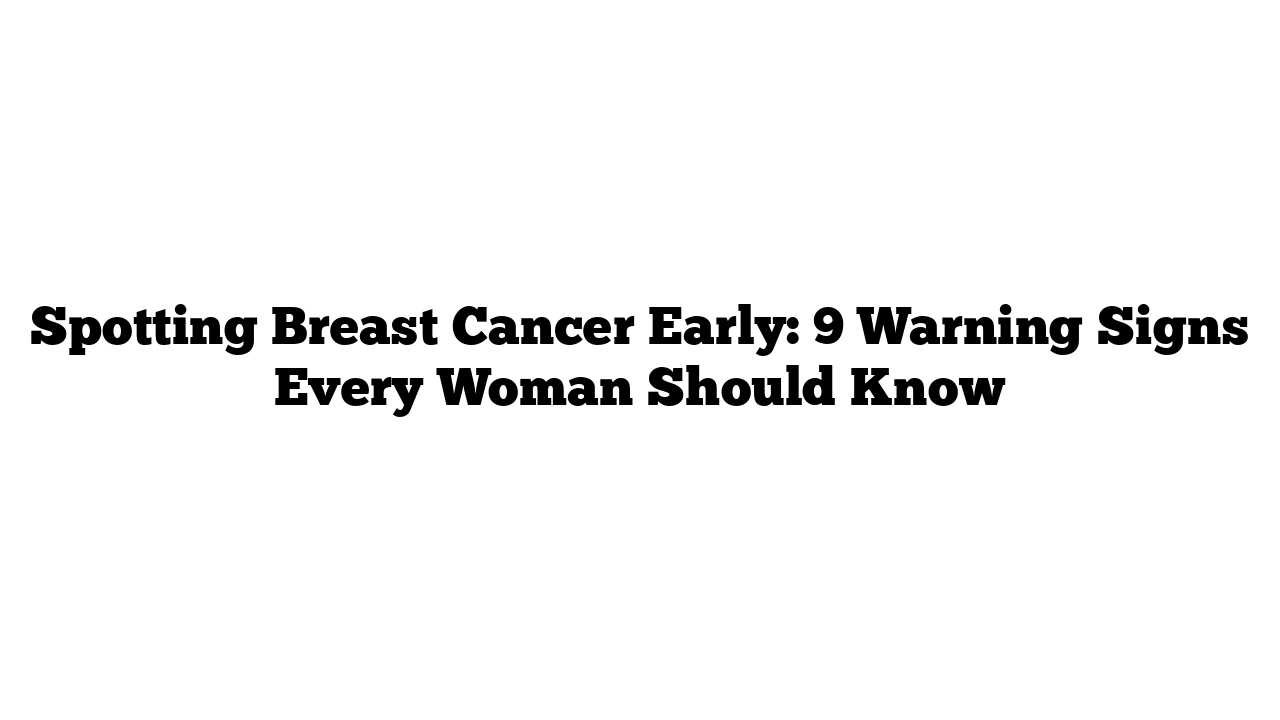Breast cancer is one of the leading causes of cancer in women, affecting approximately 14% of all women globally. Although it can develop at any age, the risk increases with age. Unfortunately, many women are diagnosed at advanced stages, making treatment more challenging and lowering survival rates.
However, early detection can dramatically improve outcomes. Knowing the warning signs empowers women to seek medical attention early and improve their chances of successful treatment. Below are 9 crucial warning signs of breast cancer that every woman should know. Pay attention to these signs, and remember that regular self-examinations and mammograms can save lives.
1. A Lump in the Breast
One of the most common symptoms of breast cancer is the appearance of a lump in the breast. These lumps often feel:
- Irregular in shape.
- Solid and distinct from surrounding tissue.
- Painless in many cases.
While not all breast lumps are cancerous (some may be benign cysts), any new lump warrants immediate medical attention. If the lump is cancerous, the skin over it might appear redder or feel tender.
2. Lumps in the Armpit or Collarbone
A less commonly recognized sign of breast cancer is a lump in the armpit or near the collarbone. These lumps may form when cancer spreads to nearby lymph nodes. They often feel:
- Hard and immovable.
- Sometimes tender to the touch.
Interestingly, these lumps may appear before a lump is noticed in the breast, making them an essential sign to monitor during self-examinations.
3. Swelling in the Entire Breast
Inflammatory breast cancer (IBC) is a rare but aggressive form of breast cancer that can cause:
- Sudden swelling of the entire breast.
- Redness and warmth in the affected area.
- An orange-peel texture to the skin (peau d’orange).
These symptoms are often mistaken for infections like mastitis, but persistent changes should be evaluated promptly.
4. Sudden Changes in Breast Size or Shape
A noticeable, sudden change in breast size or shape is another warning sign. This could include:
- One breast becoming larger or heavier.
- Swelling, redness, or a burning sensation.
While minor size differences between breasts are common, abrupt and unexplained changes should not be ignored.
5. Skin Irritation or Dimpling
Persistent skin irritation, dimpling, or puckering may indicate underlying cancer. Symptoms to watch for include:
- Scaly or flaky skin.
- Uneven or puckered skin texture.
- Skin resembling the texture of an orange peel (peau d’orange).
These changes are often caused by the thickening of tissue due to a tumor.
6. Pain in the Breast or Nipple Area
While many types of breast cancer are painless, some may cause persistent discomfort, including:
- Dull aches or sharp stabbing pain.
- Burning sensations in the breast or nipple.
This pain is distinct from the tenderness associated with hormonal changes or menstrual cycles. Persistent pain requires a thorough medical evaluation.
7. Prominent Veins on the Breast
Increased visibility of veins on the breast can be a sign of an underlying tumor. This occurs because tumors may disrupt normal blood flow, causing veins to appear swollen or more noticeable. If this happens without an obvious cause (like age or recent surgery), consult a healthcare provider.
8. Nipple Discharge
Discharge from the nipple, especially if you’re not breastfeeding, can be a symptom of breast cancer. It may appear:
- Milky, yellow, green, or clear.
- Blood-streaked in some cases.
Although benign conditions like duct ectasia or hormonal changes can also cause nipple discharge, any unexplained discharge should be evaluated by a doctor.
9. Changes in the Nipple
Changes in the appearance or sensation of the nipple may signal breast cancer. This includes:
- Nipple inversion (turning inward).
- Redness, scaling, or flaking skin.
- Pain or sensitivity that doesn’t go away.
These changes often accompany other symptoms and should not be ignored.
Take Action Early
Early detection of breast cancer significantly improves survival rates. Regular self-examinations and mammograms are crucial for catching abnormalities early. If you notice any of these warning signs, schedule an appointment with your healthcare provider without delay. Prompt action can make all the difference.
For more expert health advice, visit medicaltimes.io.
FAQs
1. How often should I perform a breast self-exam?
Monthly self-exams are recommended, ideally a week after your menstrual cycle ends.
2. Can men develop breast cancer?
Yes, though rare, men can develop breast cancer and should also monitor for lumps or changes.
3. Does breast pain always indicate cancer?
No, many non-cancerous conditions like hormonal changes can cause breast pain, but persistent pain should be evaluated.
4. At what age should I start getting mammograms?
Women at average risk should start at age 40-50, but those at higher risk may need earlier screening.
5. Can I prevent breast cancer?
While there’s no guaranteed way to prevent breast cancer, maintaining a healthy lifestyle, limiting alcohol, and regular screenings can reduce risk.
